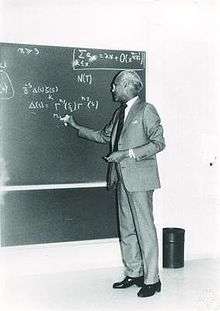K. S. Chandrasekharan
| K. S. Chandrashekhar | |
|---|---|
 | |
| Born |
21 November 1920 Bapatla, Guntur District, Madras Presidency, British India (now Andhra Pradesh, India) |
| Residence | Zurich area |
| Citizenship | Indian-Swiss |
| Fields | Number theory |
| Institutions | TIFR, ETH Zurich |
| Alma mater | Madras University |
| Doctoral advisor | K. Ananda Rau |
| Doctoral students |
C. S. Seshadri M. S. Narasimhan |
| Known for | Administrative intellect, Mathematics [Analytic Number Theory and Mathematical Analysis] |
| Notable awards | Ramanujan Medal 1966, Padma Shri 1959, Shanti Swarup Bhatnagar award 1963, |
Komaravolu S. Chandrashekhar (born 21 November 1920)[1] is a professor emeritus at ETH Zurich.[2] and a founding faculty member of School of Mathematics, Tata Institute of Fundamental Research (TIFR). He is known for his work in number theory and summability and was given numerous awards including Padma Shri, Shanti Swarup Bhatnagar Award, Ramanujan Medal, and Honorary fellow of TIFR.
Biography
Mr.Chandrashekhar was born in 1920 to a School head master Padmakshamma. Chandrashekhar completed his high school from Bapatla village in Guntur from Andhra Pradesh. He completed his M.A. in mathematics from the Presidency College, Chennai and a PhD from the Department of Mathematics, University of Madras in 1942, under the supervision of K. Ananda Rau.
When Chandrashekhar was with the Institute for Advanced Study, Princeton, USA, Homi Bhabha invited Chandrashekhar to join the School of Mathematics of the Tata Institute of Fundamental Research (TIFR). Chandrashekhar persuaded mathematicians from all over the world, to visit TIFR and deliver courses of lectures. They were L. Schwarz, C. L. Siegel and many more. In 1965, Chandrashekhar, after the death of Dr. Homi Bhabha in a plane crash, left the Tata Institute of Fundamental Research to join the ETH Zurich,[1] where he retired in 1988.[3][4]
In 2012 he became a fellow of the American Mathematical Society.[5]
Selected works
- with Salomon Bochner: Fourier Transforms. Princeton University Press. 1949.[6]
- with S. Minakshisundaram: Typical means. Oxford University Press. 1952.[7]
- Introduction to analytic number theory. Springer. 1968.[8] reprinting 2012
- Arithmetical Functions. Grundlehren der Mathematischen Wissenschaften. Springer. 1970.[8]
- Elliptic Functions. Springer. 1985.
- Classical Fourier transforms. Springer-Verlag. 1989.
- Course on topological groups. Hindustani Book Agency. 2011.
Notes
- 1 2 "Some Famous Indian Scientists" (PDF). Mumbai, India: Tata Institute of Fundamental Research, Science Popularisation and Public Outreach Committee. 14 November 2004. p. 12. Retrieved 26 May 2009.
- ↑ Komaravolu Chandrashekhar
- ↑ "Department of Mathematics Retired Faculty". Eidgenössische Technische Hochschule Zürich. 4 February 2005. Retrieved 26 May 2009.
- ↑ "ETHistory Selbstständige Professuren" (in German). Eidgenössische Technische Hochschule Zürich. 2005. Retrieved 26 May 2009.
- ↑ List of Fellows of the American Mathematical Society, retrieved 10 November 2012.
- ↑ Segal, I. E. (1950). "Review: Fourier transforms, by S. Bochner and K. Chandrasekhar" (PDF). Bull. Amer. Math. Soc. 56 (6): 526–528. doi:10.1090/s0002-9904-1950-09436-1.
- ↑ Kuttner, B. (1954). "Review: Typical means, by K. Chandrasekhar and S. Minakshisundaram" (PDF). Bull. Amer. Math. Soc. 60 (1): 85–88. doi:10.1090/s0002-9904-1954-09760-4.
- 1 2 Stark, H. M. (1971). "Review: Introduction to analytic number theory, by K. Chandrashekhar; Arithmetical functions, by K. Chandrashekhar; Multiplicative number theory, by Harold Davenport; Sequences, by H. Halberstam and K. F. Roth" (PDF). Bull. Amer. Math. Soc. 77 (6): 943–957. doi:10.1090/S0002-9904-1971-12812-4.